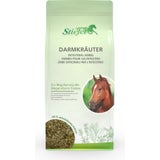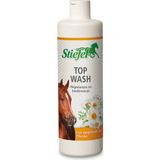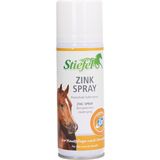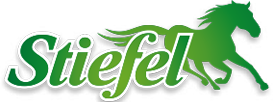Help! My horse is too fat
A report on EMS - Equine Metabolic Syndrome
By Amelie Kokorsky
The disease EMS or Equine Metabolic Syndrome has not been known in science and medicine for very long. Nevertheless, due to the increasing number of illnesses / this syndrome, it is a common diagnosis among "horse people". In almost every stable there are one or more horses living with the diagnosis of EMS. In this report we want to talk about this syndrome and take a closer look at the possible causes, symptoms and treatment methods.
What is Equine Metabolic Syndrome and how can it develop?
EMS is the derailment of the metabolism. The metabolism of diseased horses therefore works differently than the metabolism of healthy horses. In fact, humans and the management and feeding of the steppe animal horse introduced by humans are the actual cause of Equine Metabolic Syndrome. The cause for the development of EMS can therefore actually be explained quite simply: In the past, it was very rare to see a fat horse. In general, horses were mostly seen in the field, pulling a plough or under a rider. The only stood in the stable or on the pasture for a few hours or for a night's rest. There was also very little to eat, because the farmers had to work hard for the hay or buy it at a high price. So they saved on feed. Additional feed such as muesli, beet pulp, mash or treats were only given in very rare cases, for example, when something was left over from the harvest or when the apple on the tree had a brown spot. The horses, like wild horses today, had to work a lot for their food and cover long distances or work long days.
Nowadays, the daily routine of our horses looks different. Mostly our horses have access to hay or haylage all day long. In addition, there is a large portion of muesli and/ or mash in the morning and evening. When the rider enters the stable, we give them apples, carrots and/ or treats. The amount of daily exercise is usually rather low. Many riders underestimate the stamina and athletic performance of their four-legged friend. Often the horses are under- rather than overstrained, both mentally and physically. EMS can develop from the interaction of an oversupply of feed and a lack of exercise. This is why EMS is often called "the prosperity disease" of horses. With our loving management, our horses are sometimes "too well off". The body gets too many nutrients from the feed that are available too quickly and builds up fat stores.
The main cause for the development of EMS is therefore the management or the lack of exercise and the inappropriate feeding of the horses.
How do I recognize EMS?
The leading symptom of EMS is obesity!
Tip: Seek professional advice. It is often difficult to make a general statement about possible obesity based on a horse's individual body shape. Some horses are much broader and more muscular than others and therefore appear fat very quickly. Other horses are anatomically very slim, but are fed far too thickly because they otherwise look too thin in many eyes. To determine a healthy body shape, it is therefore better to get a second opinion from a veterinarian and/ or animal health practitioner.
The common thing about obesity is its "invisibility" in some horses. Many horses get fat deposits on the ridge of the neck and above the base of the tail. Fat deposits can also develop on the hose pocket or udder. These features can still be seen quite easily with the naked eye. However, if the fat forms inside the horse, i.e. around the organs, it becomes much more difficult to recognize the symptoms. Excessive fat cells can disturb the balance of the metabolism.
Due to the excessive fat storage, the horses become increasingly sluggish and lazy. They want to move less; a lack of performance occurs. The drop in performance is usually first noticed by the owners and/ or grooms. In addition, it is noticeable that the animals no longer seem to get full and could eat all the time.
Other accompanying symptoms of EMS can be insulin resistance (diabetes), laminitis and/ or respiratory diseases. However, these are separate diseases, which are favoured by EMS and often occur in combination with each other.
If EMS is suspected, it is best to consult a veterinarian and/ or animal health practitioner as soon as possible in order to prevent consequential damage as best as possible.
What happens in my horse's body when it has EMS?
The origin of this disease lies in the hormonal system. The hormonal system, whether in humans or horses, is quite complicated. You can compare it to a spider's web and the spider that goes with it. The spider monitors and controls everything that happens in the web. It decides who enters the web and how the web should be built up and dismantled every day. In the hormone system, the spider is the hypothalamus, which controls individual hormones and thus regulates many (metabolic) processes in the body. Nothing happens in the body without the hypothalamus "noticing" it. Hardly anything happens on the spider's web (in the body) without the spider (the hypothalamus) noticing it. The almost transparent threads of the spider system can be equated with the many hundreds of hormones and enzymes in our body. They are all interconnected and thus also strongly dependent on each other. If a fibre in the web is missing and a hole is created, this affects the stability of the entire web. Metabolism also works in this way. If too much or too little of a hormone is produced, it leads to malfunctions at many points in the entire metabolism.
In EMS, the hormone insulin plays a particularly important role. For this reason, EMS is also often called "horse diabetes". After a high-sugar meal, the pancreas secretes insulin. This is a good thing, because insulin lowers the blood sugar level. The sugar from the food should not float in the blood of our horses, but reach the cells where it is needed as an energy supplier. The sugar from the blood should therefore be transported to the muscles. Insulin opens the doors at the muscle cell, so to speak, and allows the sugar to enter the muscle cell. There, the horses need the sugar as an energy supplier, among other things for daily exercise. The liver can also open the doors for sugar and serves as a store for the sugar. With the release of insulin, the sugar is distributed and the blood sugar level drops again. However, if we feed the horse too many quickly available carbohydrates, sugar constantly enters the blood, so that the blood sugar level rises sharply. As a result, insulin is released again and the sugar is distributed in the cell. However, if this process happens too often, the muscle cells and also the liver cells are "full" of sugar and cannot absorb any more sugar from the blood. The problem: the blood sugar level remains high and the muscle and liver cells no longer react to the "door opener" insulin. Insulin resistance develops, which can lead to equine diabetes (EMS). The constant oversupply of sugar (energy) then leads to fat storage. The next problem arises.
Fat cells can cause a lot of chaos and thus a lot of damage to the metabolism. Fat cells behave like drops of water that constantly fall on our spider web. The whole system is set in motion and the spider is always on alert. This movement sets metabolic processes in motion that are actually not at all desirable or can be detrimental to health. The fat cells can release messenger substances that start inflammatory processes in the body. The immune system is constantly challenged by the inflammatory processes and in the long run the immune system can be weakened. Fat cells also have an effect on the adrenal cortex. Fat cells can stimulate the adrenal cortex to release cortisol. Cortisol is the antagonist to insulin and is actually needed when blood sugar levels are low, as cortisol makes blood sugar levels rise. A release of cortisol at this moment makes no sense at all and can therefore be seen as a "fault in the system". But the vicious circle is now well and truly underway. The whole spider's web is in motion because of the many drops of water that fall on the web. As a result, the spider no longer comes to rest and the web gradually becomes more and more unstable and can break. If we apply this example to the metabolism of horses, it may become clear why EMS should not be considered harmless. The metabolism of horses suffering from EMS is strongly altered, which can lead to many secondary diseases such as laminitis.

How can I support my horse with EMS?
The crucial point in the occurrence of EMS is the optimal management of feeding and exercise. Horses suffering from EMS should be under strict feed control and exercised regularly, as far as health permits, in all three gaits. It is important to start the feed change slowly and not to radically change or even reduce the feed from one day to the next. A pure change of feed to straw can be very dangerous and is definitely not effective!
At the beginning, all quickly available carbohydrates should be reduced as much as possible. This means feeding the horse as little carrots, apples, treats or muesli as possible.
Then you slowly change the basic feed, i.e. the hay. There are several methods, some of which can be combined. On the one hand, the hay can be stuffed into hay nets so that the horse is busy eating for longer and eats much more slowly. In addition, the hay can be watered beforehand. Mixing in some straw is also a good way to reduce rapidly available carbohydrates and still provide the horse with enough feed.
Starvation or provoking long feeding breaks should be avoided in any case!
Grazing on lush grass pastures should no longer take place and instead grazing on grazed pastures should be resorted to.
Once a horse has suffered from EMS, it will most likely remain susceptible to metabolic diseases, in terms of "adiposity" or obesity, for the rest of its life. A check on optimal feed management should therefore be carried out at regular intervals.
There may be some risks involved in changing the feed, but these can be counteracted with skill.
Watering the hay can cause important minerals to be "washed" out of the hay. In order to ensure an optimal supply of minerals, the horse should be provided with a suitable mineral feed. For example, Stiefel Organic-Mineral is a grain-free mineral feed that balances the horse's mineral balance.
By mixing in straw and reducing quickly available carbohydrates in a controlled, slow manner, it can happen that important proteins are also cut from the horse's feed plan. To ensure that the four-legged friend is still supplied with sufficient protein, the horse can be fed Stiefel Amino Plus daily. Stiefel Amino Plus can support muscle development and maintain performance due to the essential amino acids it contains, even though the horse is accustomed to a low feed dose at the same time.
With the onset of the diet, some "waste products" of the metabolism accumulate in the body. These are metabolised by the liver, among others. In order to optimally support the liver during the change of diet, the daily administration of selected herbs can be a sensible addition to the diet. Stiefel Liver Herbs contain a combination of herbs that contain bitter and tannic substances that can support liver function. As explained above, the liver can suffer greatly from EMS because of the constant overload of sugar and the insulin resistance that can occur at the end. In order to rebalance the receptors for insulin on the liver, the administration of Stiefel Liver Herbs can be very useful, as these contain milk thistle and black cumin seeds, among other things, which can help regenerate the liver cells. The regulation of blood sugar levels can be improved with a functioning liver.
The "waste products" mentioned above, which are produced during feed conversion and fat breakdown, not only pass through the liver, but also through the kidneys in the end. Optimal kidney function is therefore also important. Stiefel Kidney Herbs can help support kidney function naturally and promote the elimination of the "waste products".
Due to the high proportion of fatty tissue, inflammatory reactions can occur in the horse's organism as a result of the release of "wrong" messenger substances. These inflammations can put additional strain on the horse's immune system. If the immune system is weakening, Stiefel Immunity Herbs, Stiefel Rosehips and Stiefel Echinacea can strengthen the horse's defenses and provide positive support in combating the inflammatory processes.
In terms of training, interval training is particularly suitable for stimulating the fat metabolism. However, most horses have to be accustomed to this type of training slowly. At the end, one should create short intensive phases in trot and canter work, which alternate with walk phases. The intensity and duration of the strenuous training phases can be increased over time. However, the walk phases should never be reduced completely, as it is precisely these phases in interval training that are important for fat loss.
Conclusion
EMS is becoming more and more common these days. However, in most cases it is a disease where the human is the trigger. Therefore, it is often up to the human being to help the horse in the best possible way by changing the factors mentioned.
There are many ways and possibilities to fight EMS. You definitely do not have to accept this syndrome and think that it is hopeless. Rethink the feed and change the training! This will lay the foundation for a better future. So go to the stable - starting today, something will change.
Latest reviews
-
 5.0 (12)
5.0 (12)Stiefel Intestinal Herbs, 1 kg
Bestseller- 100% natural herbal mixture
- For digestive problems
- To regulate the gastrointestinal tract
£21.49 (£21.49 / kg)Delivery by May 05
-
 4.8 (9)
4.8 (9)Stiefel Devil´s Claw, Chopped, 1 kg
Bestseller- Good for joints & tendons
- Chopped roots
- Can have a positive effect on the musculoskeletal system
£26.23 (£26.23 / kg)Delivery by May 05
-
 £8.68 (£17.36 / l)
£8.68 (£17.36 / l)Delivery by May 05
-
 £9.56 (£47.80 / l)
£9.56 (£47.80 / l)Delivery by May 05
-
Great Britain: Free standard delivery from £79.90
-
Free
returns Secure payments
with SSL encryption technology

